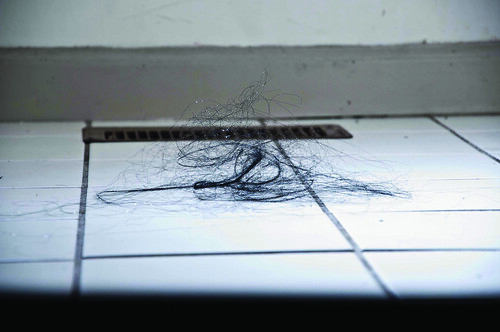When it comes to human hair, there seems to be a double standard. Columnist Sarah Sanders examines male and female hair dos and don’ts.

Every time our friend Jason comes to visit, he sheds. He’s in the house five minutes, and already, I’ve found one of his hairs in my mouth. His hair doesn’t quite reach his shoulders, but it’s just long enough to end up wrapped around my fingers as I’m scrubbing dishes in the sink. And he doesn’t bother to tame it. Once “Don’t Lose Your Love Tonight” by Outfield comes on the speakers, his head starts rocking, dispersing hundreds of brown 8-inch hairs throughout the house.
Jason’s a wonderful houseguest, and I surely appreciate his visits. But the hair – it’s unruly. I empathize with him, however, because society’s mandates concerning hair are quite confusing. You never know when to cut it, shave it, grow it, spray it, dye it, curl it, wash it, et cetera. And who’s to say any individual’s hair standards are superior to another’s? Jason’s hair lives the way it wants to, and that means in our sink, on the bookshelf and in our smoothies.
So how should we handle hair? And what hair are we talking about? We hear different things about different hairs on different parts of the body. How do we know what to listen to and what to disregard?
Let’s tackle the head first, since that’s where most of Jason’s hair energy seems to go. Hair is more likely to fall out the more you mess with it. Jason has the habit of combing his hair with his fingers. But not many people could go a day without touching their heads.
Freshman geography and urban studies major Annie Preston went two weeks, however, during a hiking trip.
“I didn’t wash it the whole time because we were in the wilderness,” she said. “I don’t even own a hairbrush or a comb.”
Like Jason, Preston’s hair can be intimidating, even for hairdressers. She said they’ll say things like, “You should have warned us” once they get a glance.
“It takes about 30 to 40 minutes to blow-dry and then another 30 to 40 minutes to straighten,” she said. “That’s why I stick to the no-maintenance routine.”
Although I don’t have a mane like Preston’s, I also prefer a low-maintenance haircut. I keep my hair relatively short so I don’t run into issues like Jason’s.
Moving down, we reach a hairy area of great contention: the armpits. I say contention because of the gender distinction in this area – hair’s OK for boys but not for girls.
Due to this standard, we women spend countless hours and dollars on this “hygienic” process that we’ll never get back. For those of you who haven’t experienced this ritual, shaving the pits involves taking a razor and running it along some pretty sensitive skin (have you ever been tickled under the arms?) repeatedly throughout any given week so the surface stays relatively smooth. Armpit hairs prove to be mighty sneaky, however, creeping out mere hours after you shave – and thicker than ever before.
I suppose this inequality between the sexes extends to the legs. How to handle it, though, is not really up to me, or anyone for that matter. It’s up to you. Two years ago, I decided to give up the dream of being silky and have settled for grizzly. But you should do what makes you feel comfortable. If that means nicks on the uneven parts of your knee or razor burn, then so be it.
In my jump to the legs, I missed a very special area of the human body, where hair becomes an entirely new phenomenon. Maybe you’ve had a Brazilian wax or heard rumors that trimming your pubes will make you look “bigger.”
Regardless, I’m sure hair down there has been a big deal to you at some point in your life. Why? Because we only show it to certain people worthy of seeing it – or we don’t want them to see any hair at all. I would get a quote from a Temple student concerning this issue, but it’s difficult to get people to talk about this hair. Plus, I may not be so worthy. The only advice I can really give is to be careful, and don’t hurt yourself if you choose to do a little grooming.
Concerning the issue of hair, we may not have covered everything (pun intended), but we’ve established that it’s not just dead skin cells.
Hair is a vehicle we use to express many things about ourselves, and it can be handled in many different ways. Furthermore, it reminds us that we may be humans, but animals nonetheless. Thus we cannot always expect to be able to tame our manes, although we’ll certainly try.
Sarah Sanders can be reached at sarah.sanders@temple.edu.



i love this blog. i enjoy it !